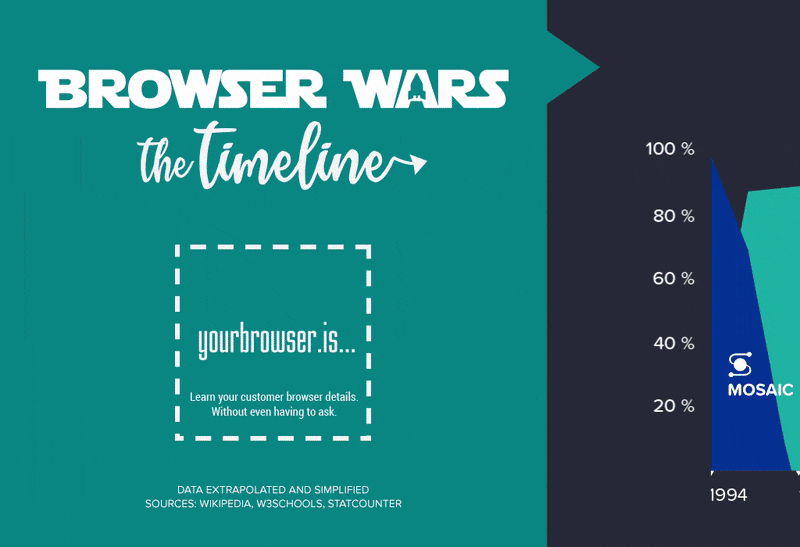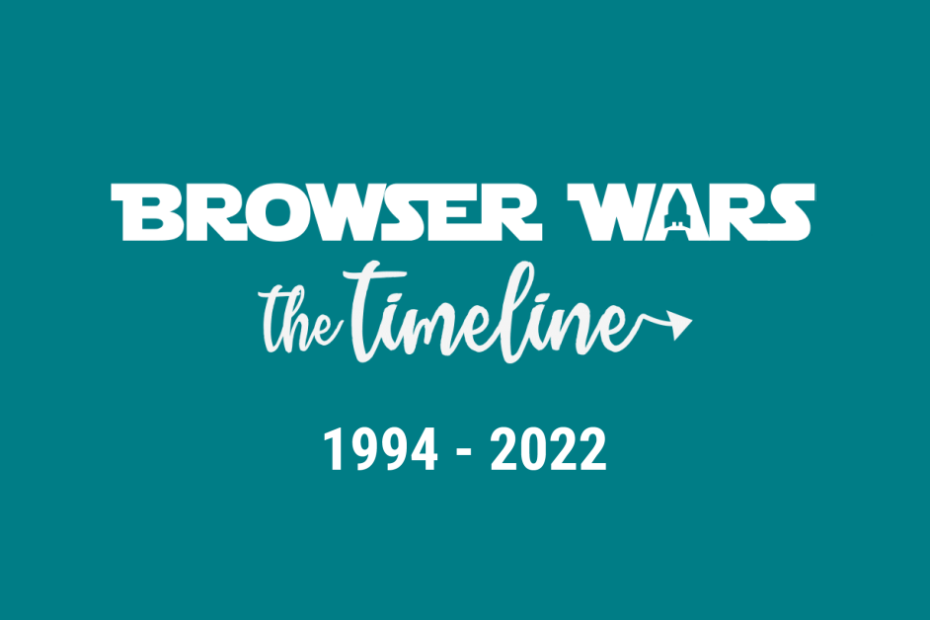See how browser market has been changing over time since 1994 – on the Horizontal Scrollable Infographic, on the Animated GIF Infographic or on the Video Infographic. And read How the Battle Started, And How It Is Going.
Horizontal Scrollable Infographic
[scriptless heading=””]
Embed the Scrollable Infographic on your blog or website using the following code:
<a href="https://yourbrowser.is/browser-wars-the-timeline-1994-2022-infographic/" target="_blank" title="Browser Market Share"><div style="overflow: auto;overflow-y:hidden;max-width:100%;height:700px;padding:0;margin:0;"><img src="https://yourbrowser.is/wp-content/uploads/2022/10/browser-wars-1994-2022.png" alt="Browser Wars: The Timeline 1994-2022 (infographic)" style="margin:0;padding:0;border:0;max-width:none;" /></div></a>or use your custom code, but don’t forget to link back to this page. Thanks.
Animated GIF Infographic

[scriptless heading=””]
Embed the GIF Infographic on your blog or website using the following code:
<a href="https://yourbrowser.is/browser-wars-the-timeline-1994-2022-infographic/" target="_blank" title="Browser Market Share"><img src="https://yourbrowser.is/wp-content/uploads/2022/10/browser-wars-1994-2022.gif" alt="Browser Wars: The Timeline 1994-2022 (GIF infographic)" style="max-width:800px;width:100%;border:0;" /></a>or use your custom code, but don’t forget to link back to this page. Thanks.
Video Infographic
[scriptless heading=””]
Embed the Video Infographic on your blog or website using the following code:
<video controls="" width="100%"><source src="https://yourbrowser.is/wp-content/uploads/2022/10/browser-wars-1994-2022.mp4" type="video/mp4"/><source src="https://yourbrowser.is/wp-content/uploads/2022/10/browser-wars-1994-2022.webm" type="video/webm"/></video><br />
Source: <a href="https://yourbrowser.is/browser-wars-the-timeline-1994-2022-infographic/" target="_blank" title="Browser Market Share">Browser Wars: The Timeline 1994-2022</a>About
Data sources: Wikipedia, W3Schools, Statcounter.
Data compiled, extrapolated, simplified and used on the infographics above by Yourbrowser.is Team.
Infographic License: CC BY-ND (Creative Commons Atribution-NoDerivs)
Yourbrowser.is is a free tool helping Web Developers quickly detect end-user’s browser details.
A Brief History of Web Browsers: How the Battle Started, And How It Is Going
While some users may indifferently use any browsers they find on their computer, many others use to define a specific web browser as their favorite one. In any case, you may have wondered where your favorite browser comes from, how it has reached its current position today, and how it has changed over time.
The long history of web browsers got started back in the 1990s. Many users don’t know the history behind their web browsers, and if you are one of them, this post is for you.
Mosaic And Netscape
The development of Mosaic was started in 1992 by NCSA, and it was where the Internet got started. Officially released in 1993, Mosaic was the first real web browser as we know it today.
Later in 1997, the parent company rebranded Mosaic as Netscape Communications Corporation. It was then renamed again to Mosaic Netscape and finally introduced as Netscape Navigator in subsequent versions.
JavaScript, which is the scripting language used in modern web browsers, was used for Netscape Navigator for the first time. Modern browsers such as Mozilla Firefox are based on Netscape Navigator today. The final version of Netscape was released in 2008, and the browser was then discontinued.
Internet Explorer
When Mosaic lost the battle to Netscape in 1997, Microsoft licensed it to create its browser in 1995: Internet Explorer. It was used on all Windows machines, and Microsoft stopped supporting it in 2016. Recently, the browser was completely killed and is being phased out of all Windows machines. Microsoft also released a version of the browser for Macs too.
In the early 2010s, Internet Explorer stopped supporting new features of HTML, CSS, and JavaScript. Then, many developers also stopped supporting the browser in their codes. During that period, countless users had already migrated to Google Chrome and Firefox, as well as Safari for Mac users.
AOL
AOL Explorer was a graphical web browser developed by AOL. It was a free, standalone download at the time of its release. Additionally, users could install it as an optional software bundled with AOL Instant Messenger.
AOL Explorer used Microsoft’s Trident browser engine and was the first browser to support tabbed browsing. The last version of the browser was launched in 2006 coming with features like Desktop Widgets, Visual Themes, a Feeds Screensaver, and different performance improvements.
Original Mozilla and Firefox
Mozilla created an internet suite back in 1999. Their initial browser name was Phoenix, released in 2002. It was then renamed Firebird, and then Firefox in 2004. The original version of the Mozilla browser was not discontinued; instead, its name was changed to Mozilla SeaMonkey. It is still in use and actively developed today.
Both the original Mozilla and Firefox browsers use the Gecko engine. They both have sentimental roots in history as they are the closest ancestors to Netscape Navigator. If the development of Netscape would continue, it could look very similar to the current Firefox today.
Opera
The development of Opera was originally started in 1994 as a research project at Telenor, the largest telecommunications company in Norway. A year later, it was branched out into a separate company in the name of Opera Software ASA. The first browser format was then released in 1996, and it has gone through several changes and improvements since then.
Opera was known for its MDI and Hotlist features that made browsing several pages at once much easier. Also, it was the first browser that adhered to the W3C standards. Although holding a small share of the whole market, the Opera browser is still actively used worldwide.
Google Chrome
Chrome was initially released in 2008 for Windows XP and newer, but was quickly ported to Linux, Mac, iOS, and Android. Initial rumors regarding the development of a browser by Google were spread in 2004 when Google was hiring Microsoft web developers, shortly after the release of Firefox 1.0, which was taking the market share from Internet Explorer at the time.
Shortly after the initial release, Chrome gained about 1 percent of the browser market share. Then in 2009, Google released beta versions of Chrome for Mac and Linux. Released in 2010, Chrome 5.0 was the first stable version to support all three main platforms.
Currently, it is estimated that Chrome has 67 percent of the market share worldwide on PCs. It is the most-used browser on tablets today (surpassing Safari), and is also dominant on smartphones. Across all platforms combined, Chrome now holds 65 percent market share. Upon this fabulous success, Google has expanded the browser to other products such as Chrome OS, Chromecast, and so on.
Apple Safari
Apple released the Safari web browser for its Mac devices in 2003. The company started working on it in 1998 and named the project Webkit. It was an original browser engine and many browsers today are built based on it. Even Chrome and Chromium also used Webkit as their engine.
In 2007, Apple released a preview of Safari for Windows. A stable version of the browser came for Windows later in 2008. The company worked on porting Webkit for Windows since 2003. This eventuality helped Google create its browser, Chrome, which is the most popular browser in the world today.
Microsoft Edge
Edge was first released in 2015 for Windows 10 and Xbox One. It was then ported to other platforms: iOS, Android, Mac, older Windows versions, and Linux. It was released as the successor of Internet Explorer.
The original version of Edge is today known as Microsoft Edge Legacy. It was built with Microsoft’s engine EdgeHTML and their Chakra JavaScript engine. Then, Microsoft started rebuilding the browser with new engines.
Microsoft stopped security support for Edge Legacy in 2020, and the new version of Edge was then released in 2020. Surpassing Apple Safari, Microsoft Edge is today the second most popular browser in most countries other than the U.S.
Brave
Brave Software was initially founded in 2015. The first version of the browser was released in 2016 with ad-blocking capabilities. Later in 2019, the company launched the stable release of the browser, gaining 8.7 million monthly active users overall. The release included almost all main features for all platforms, including iOS, Android, Windows 10, Mac, and Linux. The number of Brave’s monthly active users then soared to 20 million in 2020 and then over 36 million in 2021. Brave built its specific search engine in 2021 out of Tailcat which was originally designed to deliver search results without logging user activity or creating profiles. The browser’s search engine surpassed 2.5 billion queries in 2022 after it exited the beta phase.

